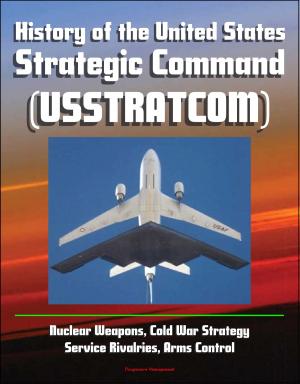Air Force Doctrine Document 1-1, Leadership and Force Development: Leading Airmen
Nonfiction, Science & Nature, Technology, Aeronautics & Astronautics, History, Military, Aviation| Author: | Progressive Management | ISBN: | 9781476350172 |
| Publisher: | Progressive Management | Publication: | April 10, 2012 |
| Imprint: | Smashwords Edition | Language: | English |
| Author: | Progressive Management |
| ISBN: | 9781476350172 |
| Publisher: | Progressive Management |
| Publication: | April 10, 2012 |
| Imprint: | Smashwords Edition |
| Language: | English |
Air Force Doctrine Document (AFDD) 1-1, Leadership and Force Development, is the Air Force's capstone doctrinal publication on leadership and how the Service uses force development to build leaders. AFDD 1-1 is a direct descendant in a line of Air Force documents chronicling leadership for the Service dating back to its earliest days. It presents the best practices of how an Airman leads and why leadership for an Airman differs from those of other Services. The three chapters and the appendices describe what an Airman is, how Airmen lead, what force development is, and how it is put into practice.
Chapter 1, The Airman, explains what an Airman is and how the Airman's perspective is integral to his or her thinking. It gives an overview of the total force, explaining the differences in leadership by officers, enlisted members, and Department of the Air Force civilians, along with a description of the specialized leadership needs and limitations when dealing with contractors. It provides the authoritative source for the Air Force core values, along with the supporting characteristics of valor, courage, and sacrifice that are fundamental to what an Airman is. It describes the mindset an Airman needs to conduct warfighting and how the profession of arms is key to what an Airman does. The Airman's Creed is located in this chapter to show its relationship to both the concept of what an Airman is and how this creed is vital to leadership in the Air Force.
Chapter 2, Leading Airmen, defines leadership for the Air Force. It discusses the foundations of leadership for the Service, with a historical analysis of the origins of leadership in the Air Force. It introduces the levels of leadership used in the Air Force for force development: tactical expertise, operational competence, and strategic vision. This expands the discussion of levels of leadership from the previous edition to provide greater fidelity to the concepts, along with more descriptive terminology that is more representative of how leadership is executed. It describes institutional competencies and leadership actions, and how these leadership components are key to developing leaders.
Chapter 3, Force Development, defines the term force development for the Air Force. It describes the force development construct and the continuum of learning with its three elements of education, training, and experience. The corporate body for ensuring there is a deliberate process employed in developing the workforce is explained. Institutional competencies and how they are used to identify desired expectations for the total workforce are clarified. The institutional competency assessment strategy illustrates how graduates are surveyed to determine how well the military education and training schools have taught them to perform the institutional competency descriptive behaviors at the prescribed proficiency levels. Common guiding principles demonstrate how education, training, and experience affect the development of Airmen.
The appendices provide supporting material for the discussion of leadership and force development. The oaths of office and enlistment provide a source of leadership for the Air Force. The code of conduct for members of the Armed Forces of the United States grounds all members of the Armed Forces with the same requirements of conduct. The institutional competency list is the definitive listing of the Air Force's institutional competencies and their subcompetencies, along with their definitions. The discussion of education and training is provided to differentiate between these concepts so they can be better understood in the context of force development. The leadership studies provide real-world examples of the three levels of leadership practiced by Airmen.
The principal audience for this AFDD is all Airmen in the US Air Force.
Air Force Doctrine Document (AFDD) 1-1, Leadership and Force Development, is the Air Force's capstone doctrinal publication on leadership and how the Service uses force development to build leaders. AFDD 1-1 is a direct descendant in a line of Air Force documents chronicling leadership for the Service dating back to its earliest days. It presents the best practices of how an Airman leads and why leadership for an Airman differs from those of other Services. The three chapters and the appendices describe what an Airman is, how Airmen lead, what force development is, and how it is put into practice.
Chapter 1, The Airman, explains what an Airman is and how the Airman's perspective is integral to his or her thinking. It gives an overview of the total force, explaining the differences in leadership by officers, enlisted members, and Department of the Air Force civilians, along with a description of the specialized leadership needs and limitations when dealing with contractors. It provides the authoritative source for the Air Force core values, along with the supporting characteristics of valor, courage, and sacrifice that are fundamental to what an Airman is. It describes the mindset an Airman needs to conduct warfighting and how the profession of arms is key to what an Airman does. The Airman's Creed is located in this chapter to show its relationship to both the concept of what an Airman is and how this creed is vital to leadership in the Air Force.
Chapter 2, Leading Airmen, defines leadership for the Air Force. It discusses the foundations of leadership for the Service, with a historical analysis of the origins of leadership in the Air Force. It introduces the levels of leadership used in the Air Force for force development: tactical expertise, operational competence, and strategic vision. This expands the discussion of levels of leadership from the previous edition to provide greater fidelity to the concepts, along with more descriptive terminology that is more representative of how leadership is executed. It describes institutional competencies and leadership actions, and how these leadership components are key to developing leaders.
Chapter 3, Force Development, defines the term force development for the Air Force. It describes the force development construct and the continuum of learning with its three elements of education, training, and experience. The corporate body for ensuring there is a deliberate process employed in developing the workforce is explained. Institutional competencies and how they are used to identify desired expectations for the total workforce are clarified. The institutional competency assessment strategy illustrates how graduates are surveyed to determine how well the military education and training schools have taught them to perform the institutional competency descriptive behaviors at the prescribed proficiency levels. Common guiding principles demonstrate how education, training, and experience affect the development of Airmen.
The appendices provide supporting material for the discussion of leadership and force development. The oaths of office and enlistment provide a source of leadership for the Air Force. The code of conduct for members of the Armed Forces of the United States grounds all members of the Armed Forces with the same requirements of conduct. The institutional competency list is the definitive listing of the Air Force's institutional competencies and their subcompetencies, along with their definitions. The discussion of education and training is provided to differentiate between these concepts so they can be better understood in the context of force development. The leadership studies provide real-world examples of the three levels of leadership practiced by Airmen.
The principal audience for this AFDD is all Airmen in the US Air Force.















